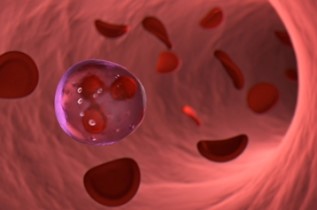
A recent NIA-funded study published in Nature Medicine presents a fascinating insight: Clonal hematopoiesis of indeterminate potential (CHIP), a genetic alteration in certain blood cells known to elevate the risk for hematological malignancies and cardiovascular disease, might paradoxically lower one’s susceptibility to Alzheimer’s disease. This discovery could shed light on the connection between blood cells and cerebral health.
Blood cells, by nature, are transient and must be continually regenerated—a process known as hematopoiesis that takes place within the bone marrow. As existing blood cells wane, a reserve of hematopoietic stem cells (HSCs) divides to form replacements. Typically, a myriad of HSCs proliferate into faithful replicas of the original cells they’re replenishing. However, under the influence of CHIP, mutations occur in the genetic code of some HSCs, leading to the creation of somewhat altered blood cells.
While individuals with CHIP often lead long lives, their predisposition to hematological cancers and cardiovascular diseases is heightened when compared to those without the condition. CHIP is prevalent among the elderly, with estimates suggesting it affects 10% to 30% of individuals over the age of 70. Prior research has mainly concentrated on its cardiovascular repercussions; its impact on neurological health remains less explored. In an effort to fill this void, investigators from Stanford University are delving into the influence of CHIP on the risk of Alzheimer’s in the aging population.
In this intriguing study, scientists meticulously examined blood samples from 1,362 Alzheimer’s patients and 4,368 non-patients, followed by decoding the genetic structure of their blood cells to identify the presence of CHIP. The analysis yielded a remarkable revelation—individuals with CHIP appeared to have a lower likelihood of developing Alzheimer’s disease.
Delving deeper, the researchers then sequenced the DNA of microglia from the brains of eight individuals with CHIP. Microglia, the brain’s immune cells, are paramount for optimal brain function and health. In the context of Alzheimer’s, these cells often malfunction, inadvertently harming the neurons they are supposed to shield. In seven out of the eight brains examined, the CHIP mutation present in the blood cells also materialized in the brain’s microglia. Though these results are still preliminary, they propose a tantalizing hypothesis that some CHIP-bearing blood cells might travel to the brain, potentially augmenting microglial functions.
Collectively, these initial findings indicate that CHIP could be a natural deterrent to Alzheimer’s. Ongoing research aims to dissect the disparity between brain immune cells with and without the CHIP mutation. Deciphering the underlying reasons for CHIP’s protective association with Alzheimer’s could offer fresh perspectives on impeding the disease’s progression.
